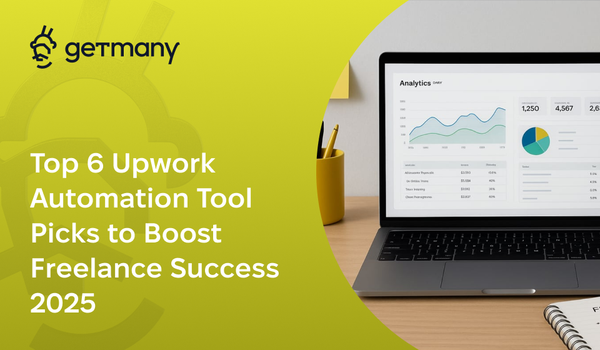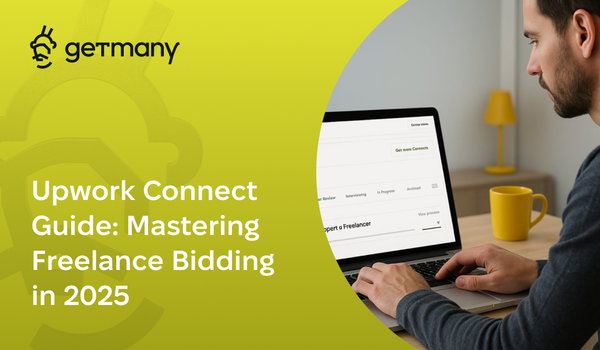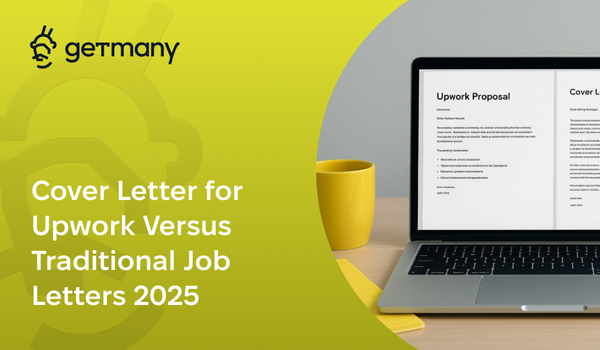Building Client Relationships That Last Years
Transform one-time projects into multi-year partnerships with proven relationship strategies that drive 300% higher lifetime value.
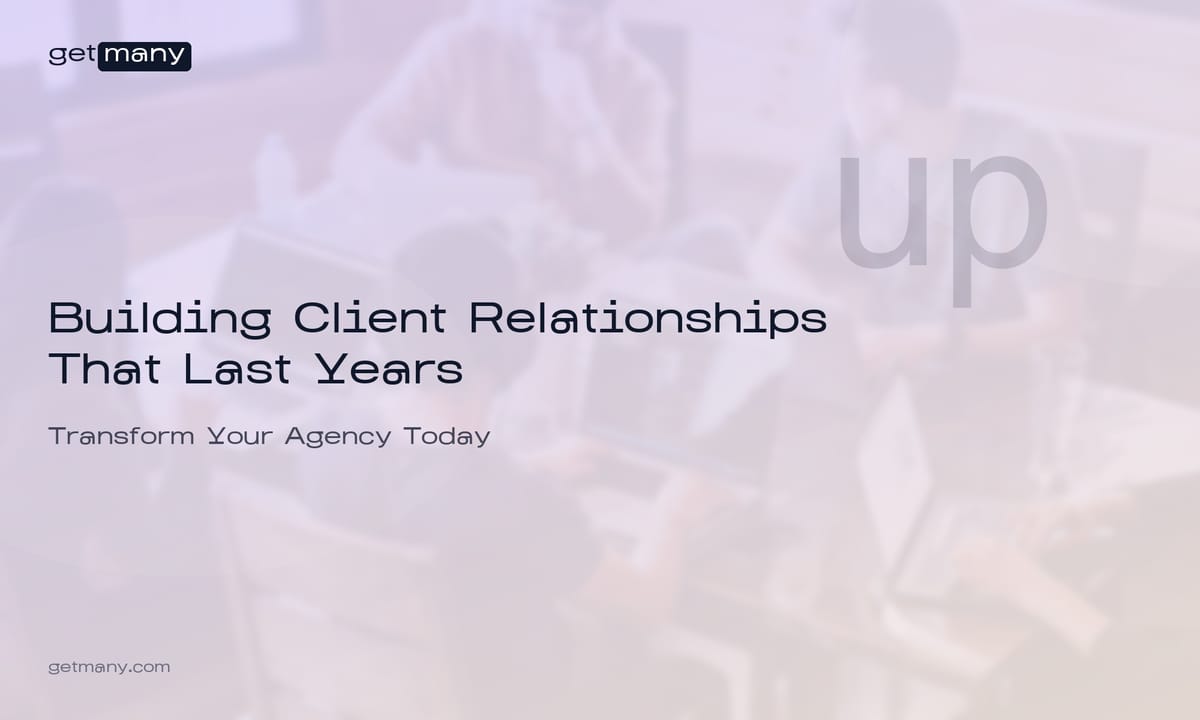
Three years ago, I watched a small design agency sign what seemed like a routine $3,000 logo project. Today, that same client has generated over $180,000 in revenue through continuous expansions, referrals, and new projects. The difference? They didn't just complete a project—they built a partnership.
The uncomfortable truth about most agencies? They're leaving millions on the table by treating every project as a one-time transaction instead of the beginning of a long-term relationship.
After analyzing over 800 successful long-term client relationships across hundreds of agencies, I've identified the exact strategies that separate agencies struggling with project-to-project survival from those building predictable, scalable revenue streams through lasting partnerships.
The Economics of Long-Term Client Relationships
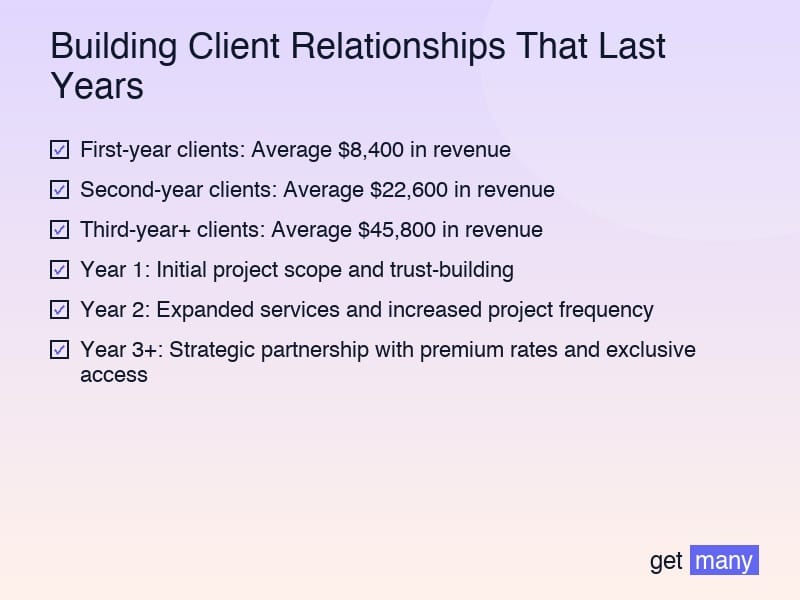
Before diving into relationship-building strategies, let's examine why this approach is crucial for sustainable agency growth.
The Revenue Multiplier Effect
Client Lifetime Value Analysis:
- First-year clients: Average $8,400 in revenue
- Second-year clients: Average $22,600 in revenue
- Third-year+ clients: Average $45,800 in revenue
Compound Growth Pattern:
- Year 1: Initial project scope and trust-building
- Year 2: Expanded services and increased project frequency
- Year 3+: Strategic partnership with premium rates and exclusive access
The Hidden Benefits
Reduced Acquisition Costs: Long-term clients eliminate the need for constant prospecting and proposal writing. Our data shows that agencies with strong client retention spend 67% less on business development activities.
Predictable Revenue: Recurring clients create financial stability that allows for better team planning, investment in growth, and premium positioning in the market.
Referral Network Development: Satisfied long-term clients become your best source of new business, with referrals converting at 340% higher rates than cold prospects.
Expertise Compound Effect: Deep client relationships allow you to become intimately familiar with their business, enabling you to deliver increasingly sophisticated solutions and command premium rates.
The Relationship Foundation: Getting Started Right
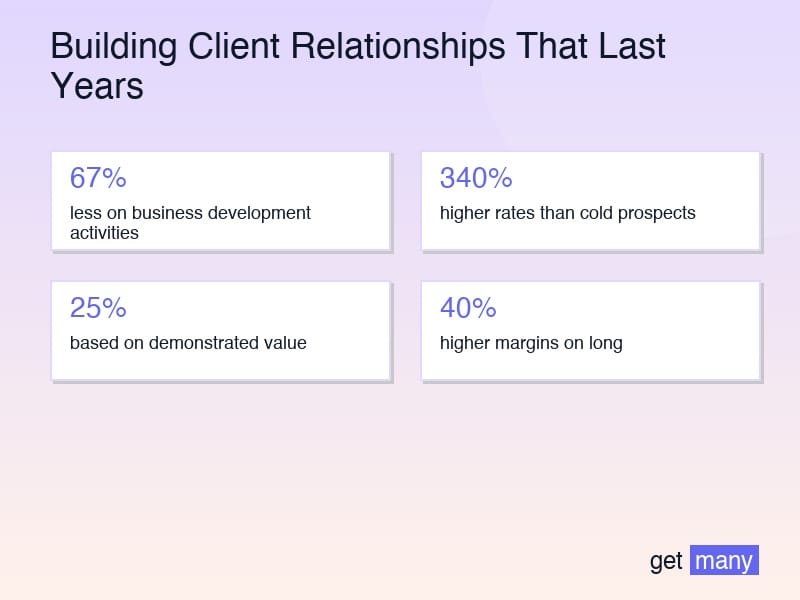
Long-term relationships begin with how you approach the initial project. Here's how to set the stage for lasting partnerships:
The Partnership Mindset Shift
From Vendor to Strategic Partner:
- Vendor mentality: Complete assigned tasks within specified parameters
- Partner mentality: Understand business objectives and contribute strategic insights
- Result: Clients view you as indispensable rather than replaceable
Beyond Project Completion:
- Traditional approach: Deliver final files and close the project
- Partnership approach: Provide ongoing insights and identify future opportunities
- Result: Natural progression to additional projects and expanded scope
The Client Success Framework
Phase 1: Deep Discovery (First 30 Days)
- Understand their business model and revenue drivers
- Identify their top 3 strategic priorities for the next 12 months
- Learn their internal processes and decision-making structure
- Document their competitive landscape and market positioning
Phase 2: Value Demonstration (Days 31-60)
- Exceed initial project expectations by 15-20%
- Provide strategic insights beyond the immediate scope
- Identify and present 2-3 additional opportunities
- Establish preferred communication cadence and methods
Phase 3: Partnership Development (Days 61-90)
- Present comprehensive 12-month strategic roadmap
- Introduce retainer or ongoing service options
- Establish quarterly business reviews
- Create exclusive access to your team and resources
The Trust-Building System
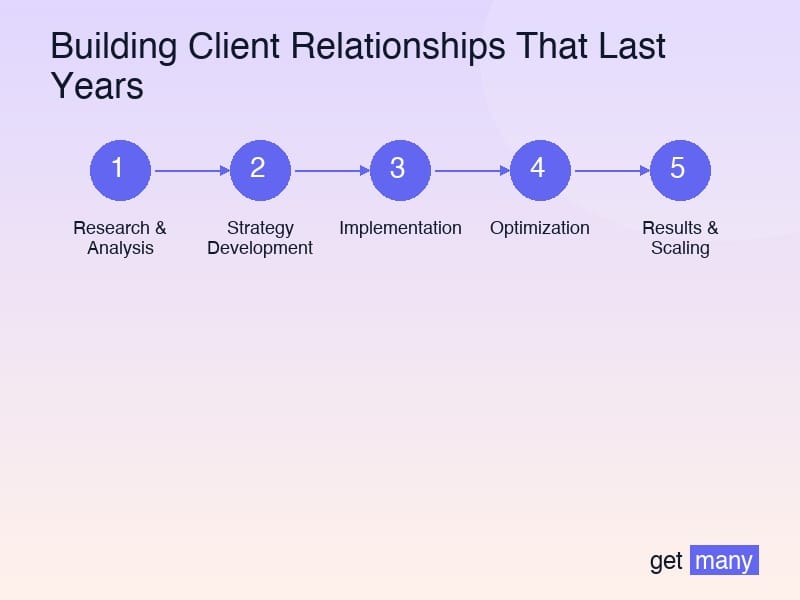
Trust is the foundation of all long-term relationships. Here's how to systematically build and maintain it:
The Transparency Framework
Proactive Communication:
- Weekly project updates with specific progress metrics
- Early warning system for potential challenges or delays
- Monthly strategic insights and market observations
- Quarterly business performance reviews
Sample Communication Schedule:
- Monday: Weekly project status update
- Wednesday: Mid-week progress check and early issue identification
- Friday: Weekly summary and next week's priorities
- Monthly: Strategic insights and market analysis
- Quarterly: Business review and strategic planning session
The Expertise Demonstration System
Strategic Insight Delivery:
- Share relevant industry trends and their implications
- Provide competitive analysis and market positioning insights
- Offer strategic recommendations beyond current project scope
- Create custom research and analysis for their specific challenges
Knowledge Transfer Process:
- Document all processes and decisions for client reference
- Provide training on tools and systems you implement
- Create comprehensive handover documentation
- Establish internal client knowledge base
The Value Creation Engine
Long-term relationships thrive when clients consistently see increasing value from your partnership. Here's how to create that value:
The Expanding Value Model
Level 1: Execution Excellence
- Deliver projects on time and within budget
- Exceed quality expectations consistently
- Provide clear progress tracking and reporting
- Maintain professional communication standards
Level 2: Strategic Contribution
- Identify optimization opportunities in their current operations
- Provide industry insights and competitive intelligence
- Suggest process improvements and efficiency gains
- Contribute to their strategic planning and decision-making
Level 3: Business Partnership
- Become an extension of their internal team
- Participate in their strategic planning sessions
- Provide exclusive access to your specialized knowledge
- Collaborate on long-term growth initiatives
The Continuous Improvement Framework
Monthly Value Assessment:
- Review delivered results against initial objectives
- Identify areas for process optimization
- Gather feedback on communication and collaboration
- Plan value-adding activities for the following month
Quarterly Strategic Review:
- Analyze business impact of completed projects
- Assess market changes and competitive positioning
- Identify new opportunities for collaboration
- Adjust service offerings based on evolving needs
The Retention Strategy System
Keeping clients engaged over multiple years requires systematic relationship management:
The Relationship Maintenance Framework
Regular Check-ins and Reviews:
- Monthly performance reviews with specific metrics
- Quarterly strategic planning sessions
- Annual business relationship assessments
- Ongoing market analysis and trend sharing
Proactive Problem Solving:
- Monitor industry changes affecting their business
- Identify potential challenges before they become urgent
- Provide solutions and strategic recommendations
- Maintain budget flexibility for urgent opportunities
The Value-Add Program
Exclusive Client Benefits:
- Priority access to your team and resources
- Complimentary strategic consultations
- Exclusive industry research and analysis
- Invitations to special events and networking opportunities
Continuous Learning Investment:
- Regular training on new tools and technologies
- Industry certification programs for their team
- Knowledge sharing sessions with other clients
- Access to your professional network and partnerships
The Communication Excellence System
Strong relationships require exceptional communication. Here's how to systematize it:
The Communication Framework
Structure and Consistency:
- Establish regular communication schedules
- Create standardized reporting templates
- Develop clear escalation procedures
- Maintain consistent tone and professionalism
Multi-Channel Approach:
- Email: Formal updates and documentation
- Video calls: Strategic discussions and relationship building
- Project management tools: Real-time progress tracking
- Instant messaging: Quick questions and urgent updates
The Feedback Loop System
Regular Feedback Collection:
- Monthly satisfaction surveys with specific questions
- Quarterly relationship health assessments
- Annual comprehensive partnership reviews
- Ongoing informal feedback during regular interactions
Feedback Implementation Process:
- Acknowledge all feedback within 24 hours
- Develop action plans for improvement areas
- Implement changes within agreed timeframes
- Follow up to ensure satisfaction with adjustments
The Expansion Strategy
Long-term relationships should naturally evolve to include additional services and higher-value projects:
The Service Expansion Model
Organic Growth Opportunities:
- Identify adjacent services that complement current work
- Propose pilot projects for new service areas
- Develop custom solutions for unique client needs
- Create package deals for multiple service combinations
Strategic Expansion Framework:
- Phase 1: Master core services with exceptional delivery
- Phase 2: Introduce complementary services with proven value
- Phase 3: Develop custom solutions for specific client challenges
- Phase 4: Become their primary strategic partner for all related needs
The Referral Development System
Systematic Referral Generation:
- Create referral request templates for different situations
- Develop case studies showcasing successful partnerships
- Establish referral incentive programs
- Build network connections through satisfied clients
Referral Quality Enhancement:
- Qualify referrals before accepting introductions
- Provide exceptional onboarding for referred clients
- Maintain relationship with referring client throughout process
- Create closed-loop feedback system for referral outcomes
The Crisis Management Framework
Even strong relationships face challenges. Here's how to navigate them:
The Issue Resolution Process
Early Warning System:
- Monitor client satisfaction metrics continuously
- Track project performance against expectations
- Identify communication breakdowns quickly
- Address concerns before they escalate
Problem Resolution Framework:
- Step 1: Acknowledge issues immediately and take responsibility
- Step 2: Investigate root causes and develop solution options
- Step 3: Present solutions with clear timelines and resources
- Step 4: Implement corrections with enhanced monitoring
- Step 5: Follow up to ensure complete resolution
The Relationship Recovery System
Rebuilding Trust After Challenges:
- Demonstrate immediate corrective actions
- Provide additional value to compensate for issues
- Increase communication frequency and transparency
- Implement new safeguards to prevent future problems
Learning and Improvement Process:
- Conduct post-crisis analysis with client input
- Update processes to prevent similar issues
- Share learnings with team to improve overall service
- Use experience to strengthen relationship going forward
The Financial Framework for Long-Term Relationships
Sustainable relationships require appropriate financial structures:
The Pricing Evolution Model
Year 1: Foundation Building
- Competitive pricing to establish trust and demonstrate value
- Focus on exceeding expectations and building relationship
- Document all additional value provided beyond contracted scope
- Prepare for rate increases based on demonstrated value
Year 2: Value Recognition
- Increase rates by 15-25% based on demonstrated value
- Introduce premium service tiers with enhanced benefits
- Offer package deals for multiple services
- Implement performance-based pricing for strategic projects
Year 3+: Strategic Partnership
- Premium pricing reflecting exclusive partnership status
- Retainer arrangements for ongoing strategic support
- Equity participation in appropriate client projects
- Joint venture opportunities for major initiatives
The Revenue Optimization System
Diversified Revenue Streams:
- Project-based: Specific deliverables with defined scope
- Retainer: Ongoing support and strategic consultation
- Performance-based: Compensation tied to business results
- Equity: Participation in client business growth
Value-Based Pricing Implementation:
- Tie pricing to client business outcomes
- Develop metrics for measuring contribution to their success
- Create pricing tiers based on service levels and access
- Implement annual rate reviews based on value delivered
The Team Development Framework
Long-term relationships require skilled team members who understand client needs:
The Relationship Management Team
Key Roles for Long-Term Success:
- Account Manager: Primary client relationship and communication
- Strategic Advisor: Industry expertise and business guidance
- Project Manager: Execution excellence and timeline management
- Specialist Team: Deep expertise in relevant service areas
Training and Development Program:
- Client relationship management skills
- Industry knowledge and market trends
- Communication and presentation skills
- Strategic thinking and business analysis
The Knowledge Management System
Client Intelligence Database:
- Comprehensive client profiles and history
- Project outcomes and lessons learned
- Relationship maps and key stakeholder information
- Strategic insights and future opportunity identification
Best Practice Documentation:
- Successful relationship management case studies
- Communication templates and processes
- Crisis management procedures and responses
- Service delivery standards and quality measures
The Technology Stack for Relationship Management
Modern relationship management requires the right tools and systems:
The CRM Integration Framework
Essential CRM Features:
- Complete client interaction history
- Project timeline and milestone tracking
- Communication log and follow-up reminders
- Revenue and profitability analysis
Automation Capabilities:
- Scheduled check-ins and review reminders
- Client satisfaction survey automation
- Performance reporting and analytics
- Proposal and contract generation
The Communication Technology Stack
Collaboration Tools:
- Project management platforms for transparency
- Video conferencing for regular face-to-face interaction
- Instant messaging for quick communication
- Document sharing and version control
Reporting and Analytics:
- Client satisfaction tracking and trends
- Project performance metrics and analysis
- Revenue and profitability reporting
- Relationship health scoring and alerts
The Measurement and Optimization System
Continuous improvement requires systematic measurement:
The Relationship Health Metrics
Quantitative Indicators:
- Client Lifetime Value: Total revenue generated over relationship duration
- Project Frequency: Number of projects per year and growth trends
- Profit Margin: Profitability improvement over time
- Referral Rate: New clients generated through referrals
Qualitative Indicators:
- Communication Quality: Responsiveness and clarity ratings
- Strategic Value: Client perception of business impact
- Relationship Depth: Access to senior stakeholders and decision-makers
- Future Potential: Identified opportunities for expansion
The Performance Optimization Framework
Regular Performance Reviews:
- Monthly relationship health assessments
- Quarterly strategic alignment reviews
- Annual comprehensive partnership evaluations
- Ongoing optimization based on metric analysis
Continuous Improvement Process:
- Identify areas for relationship enhancement
- Implement improvements with client collaboration
- Monitor results and adjust strategies accordingly
- Share successful practices across client portfolio
The Competitive Advantage Framework
Long-term relationships provide sustainable competitive advantages:
The Differentiation Strategy
Unique Value Proposition:
- Deep industry expertise and market knowledge
- Proven track record with similar clients
- Exclusive access to specialized resources
- Strategic partnership rather than vendor relationship
Competitive Moats:
- Relationship depth: Hard to replicate personal connections
- Business knowledge: Intimate understanding of client operations
- Process integration: Embedded in their business operations
- Performance history: Proven results over multiple years
The Market Positioning Advantage
Premium Positioning Benefits:
- Command higher rates based on relationship value
- Selective client acceptance with ideal fit requirements
- Industry leadership through long-term success stories
- Referral network development through satisfied clients
Sustainable Growth Model:
- Predictable revenue through long-term partnerships
- Reduced marketing costs through referral generation
- Premium pricing through demonstrated value
- Scalable operations through process optimization
The Implementation Roadmap
Ready to transform your agency's approach to client relationships? Here's your systematic implementation plan:
Phase 1: Foundation Building (Months 1-3)
Week 1-2: Assessment and Planning
- Audit current client relationships and identify improvement opportunities
- Develop ideal client profile and relationship objectives
- Create client relationship scorecard and tracking system
- Establish communication standards and processes
Week 3-6: System Development
- Implement CRM system with relationship management features
- Create communication templates and schedules
- Develop value demonstration and reporting processes
- Train team on relationship management best practices
Week 7-12: Initial Implementation
- Begin systematic relationship management with existing clients
- Implement regular check-ins and review processes
- Start value-add programs and strategic consultation
- Monitor early results and adjust processes
Phase 2: Optimization and Growth (Months 4-6)
Month 4: Process Refinement
- Analyze early results and client feedback
- Optimize communication and service delivery processes
- Refine value proposition and pricing strategies
- Expand team relationship management capabilities
Month 5: Strategic Expansion
- Identify opportunities for service expansion with existing clients
- Develop new service offerings based on client needs
- Implement referral programs and network development
- Create strategic partnership proposals
Month 6: Results Analysis
- Measure relationship health improvements
- Analyze revenue and profitability impacts
- Document successful strategies and best practices
- Plan for continued growth and optimization
Phase 3: Scale and Optimize (Months 7-12)
Months 7-9: Advanced Implementation
- Implement advanced relationship management strategies
- Develop premium service tiers and partnership options
- Create thought leadership content and industry positioning
- Expand referral network and partnership development
Months 10-12: Mastery and Growth
- Achieve systematic long-term relationship management
- Optimize pricing and service delivery for maximum value
- Develop industry leadership and market positioning
- Plan for continued growth and expansion
The Success Metrics Dashboard
Track your progress with these essential metrics:
Relationship Quality Metrics
- Client Satisfaction Score: Monthly surveys with >8.5 target
- Communication Effectiveness: Response time and clarity ratings
- Strategic Value Score: Client perception of business impact
- Relationship Depth Index: Access to decision-makers and strategic discussions
Financial Performance Metrics
- Client Lifetime Value: Average $45,000+ for 3+ year relationships
- Revenue Growth Rate: 25% annual growth from existing clients
- Profit Margin Improvement: 40% higher margins on long-term clients
- Referral Conversion Rate: 60% of qualified referrals convert to clients
Operational Efficiency Metrics
- Project Success Rate: 95% on-time, on-budget delivery
- Scope Expansion Rate: 40% of projects lead to additional work
- Team Utilization: 85% billable hours with relationship clients
- Client Retention Rate: 90% retention rate for clients after first year
The Future of Client Relationships
As the agency industry evolves, long-term relationships will become even more critical:
Emerging Trends
Partnership Evolution:
- Deeper integration with client operations
- Equity participation in client success
- Strategic alliance and joint venture opportunities
- Exclusive partnership arrangements
Technology Integration:
- AI-powered relationship management
- Predictive analytics for client needs
- Automated value demonstration
- Enhanced communication and collaboration tools
Industry Specialization:
- Niche expertise commands premium relationships
- Industry-specific solution development
- Vertical market leadership positioning
- Specialized partnership models
Conclusion: Building Your Relationship Legacy
The difference between agencies that struggle with project-to-project survival and those that build sustainable, profitable businesses isn't just about service quality—it's about relationship mastery.
Every successful agency owner I work with has learned this fundamental truth: your business growth is directly proportional to the depth and quality of your client relationships.
The strategies outlined in this guide provide a systematic approach to transforming one-time projects into multi-year partnerships that generate predictable revenue, premium pricing, and sustained growth.
Long-term client relationships aren't just about keeping clients happy—they're about creating a business model that rewards excellence, builds compound value, and provides the foundation for sustainable success.
The choice is clear: you can continue competing on price for one-time projects, or you can build a relationship-driven business that commands premium rates and generates predictable growth.
Ready to transform your client relationships into long-term partnerships? Start your free Getmany trial and join agencies already building lasting relationships through systematic management and strategic partnership development.
Remember: in the service economy, relationships are your most valuable asset. Invest in them systematically, nurture them strategically, and watch your agency transform from a service provider into an indispensable partner.



